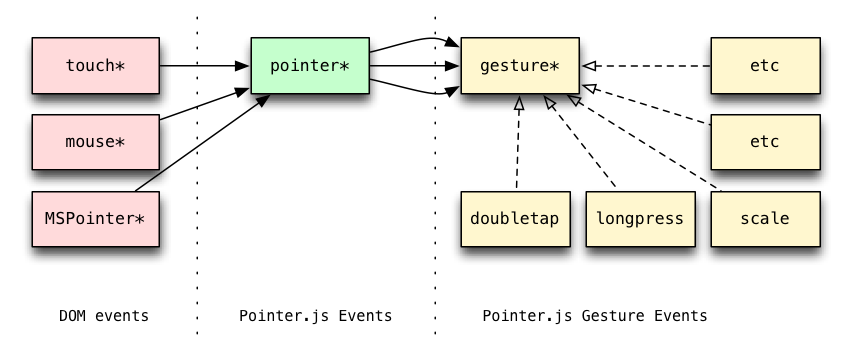Generalized input on the cross-device web
Update (August 7, 2013): Pointer.js is deprecated. Please use the PointerEvents polyfill instead.
Mouse will soon cease to be the dominant input method for computing, though it will likely remain in some form for the forseeable future. Touch is the heir to the input throne, and the web needs to be ready. Unfortunately, the current state of input on the web is... you guessed it: a complete mess! There are two separate issues:
- No unified story between mouse, touch, and other spatial input.
- Poor support for complex gestures, especially needed for touch.
I'll look at each in a bit of detail, and then show you pointer.js.
Lack of unified touch and mouse system
Most web developers should care about providing a good experience on both mouse and touch interfaces. This is increasingly true with crossover mouse-touch devices like the Transformer prime, and upcoming Windows 8 laptops.
Here's what you end up with if you want to support touch and mouse events on the web today:
$(window).mousedown(function(e) { down(e.pageY); });
$(window).mousemove(function(e) { move(e.pageY); });
$(window).mouseup(function() { up(); });
// Setup touch event handlers.
$(window).bind('touchstart', function(e) {
e.preventDefault();
down(e.originalEvent.touches[0].pageY);
});
$(window).bind('touchmove', function(e) {
e.preventDefault();
move(e.originalEvent.touches[0].pageY);
});
$(window).bind('touchend', function(e) {
e.preventDefault();
up();
});
The above is a bunch of boilerplate code that does absolutely nothing! You end up having to manually wrangle two completely different models into one.
Microsoft is taking a very smart approach with IE10 to address this issue by introducing pointer events. The idea is to consolidate all input that deals with one or more points on the screen into a single unified model.
Unfortunately, it's not being proposed as a standardized spec. Also, because it's not universally available, it will be yet another thing developers need to support (if they want to support Windows 8/Metro apps). So now our sample above gets even more boilerplate, with at least three more calls like the following:
$(window).bind('MSPointerDown', function(e) {
// Extract x, y, and call shared handler.
});
$(window).bind('MSPointerMove', function(e) {
// Extract x, y, and call shared handler.
});
$(window).bind('MSPointerUp', function(e) {
// Extract x, y, and call shared handler.
});
Although their intentions are good, this approach potentially makes the situation (hopefully temporarily) worse.
Touch gestures need to be easy
Touch UIs often involve gestures that aren't easy for developers to
implement, such as pinch-zooming and rotation. However, on the web, due
to the simplicity of the touch events, even implementing
something as simple as a button is non-trivial.
Implementing more complex gesture recognizers on top of the primitive
touch* events is even less trivial.
Frameworks like Sencha Touch and Hammer.js come to
the rescue to address the lack of gestures, however these both have
problems. Sencha comes as a complete package, and it's impossible to use
their gesture recognizer without using their whole framework (or
spending considerable effort trying to pull it out). Hammer.js, on the
other hand, doesn't actually implement gesture recognition for
pinchzoom, but instead relies on the touch spec providing non-standard
rotation and scale values pioneered by Apple.
Microsoft has a gesture layer on top of their consolidated pointer
model. This makes sense as an approach to take. True, certain gestures
only make sense for touch, and it's easy to distinguish the input type
using the event.pointerType API. That said, with a unified model,
there can be new gestures that span multiple input modalities, like
this research suggests.
Pointer.js - A solution to both problems
The solution to this problem is to write another library, tag on a .js
to the end of the name, get everyone to use it, prove that it's very
useful, and have browsers and spec implement it natively. Once this
is spec'ed, approved, and widely implemented, it should just be a matter
of removing the script tag!

Pointer.js consolidates pointer-like input models across browsers and devices. It provides the following:
- Events:
pointerdown, pointermove, pointerup - Event payload class:
originalEvent, pointerType, getPointerList() - Pointer class:
x, y, type
To use it, simply include pointer.js in your web page. This
automatically rigs addEventListener with support for pointer* and
gesture* events.
Try some simple pointer.js demos:
- Multi-touch drawing
- Pointer event logger
- Gesture event logger (supports scale, longpress and doubletap)
For more info about the library, check it out at https://github.com/borismus/pointer.js. Contributions in the form of pull requests are most welcome: more demos using pointer events, unimplemented gesture recognizers for common gestures, like swipe and rotation, and tweaks to the system itself.